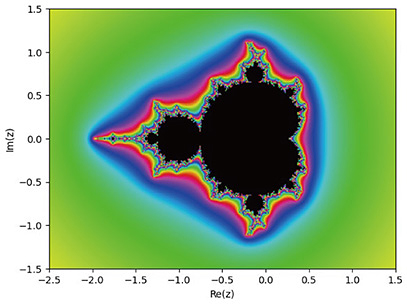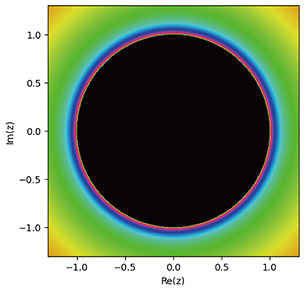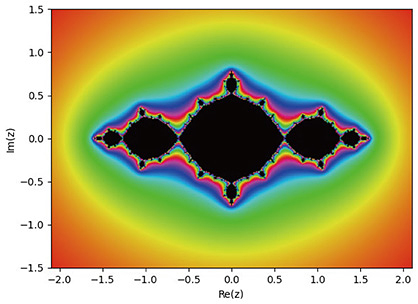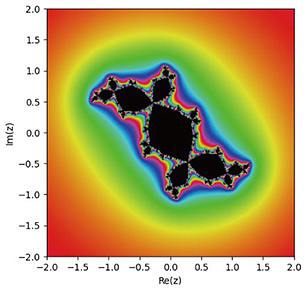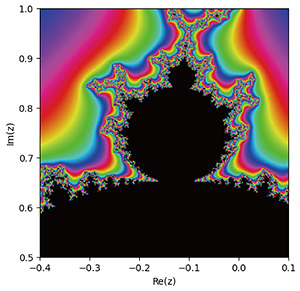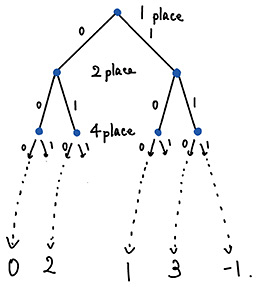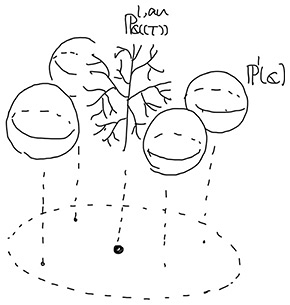 |
|||||||
|
|
|||||||
|
Feature Articles: Challenging the Unknown: Mathematical Research and Its Dreams Vol. 22, No. 9, pp. 30–38, Sept. 2024. https://doi.org/10.53829/ntr202409fa3 How Number Theory Elucidates the Mysteries of Complex Dynamics—Viewed through Non-Archimedean DynamicsAbstractThe theory of complex dynamics is an area of pure mathematics. Even though the theory of dynamical systems belongs to analysis, it is studied in relation to various fields of mathematics, including algebra and geometry. I study it using the theory of non-archimedean numbers from number theory, which seems distant from dynamics. In this article, we discuss how attractive these theories are. Keywords: dynamical systems, mathematics, weather forecast 1. IntroductionThe theory of complex dynamics is a field in mathematics that studies asymptotic behaviors of dynamical systems defined from recurrence formulae with complex coefficients. For instance, the formula
Research in this field is fascinating because of its crucial connections with other areas, such as real dynamics, arithmetic dynamics, non-archimedean dynamics, algebraic geometry, and Arakelov geometry. These areas have their methods and purposes but affect each other, i.e., if one field has significant progress, it stimulates and is applied to different fields. In this article, we explore this connection from the example of a relation between complex dynamics and non-archimedean dynamics, which is the author’s field of study, after we look at what precisely complex dynamics involves. 2. Complex dynamical systemsLet us consider the example (a) Case |x0| < 1: {xn} converges to 0; (b) Case |x0| > 1: {xn} diverges to ∞; (c) Case |x0| = 1: |xn| stays 1 for any n. In cases (a) and (c), the asymptotic behaviors are stable under small fluctuation of x0 while it is not in case (b). That is, in case (a) (resp. (c)), if we give a slight change to x0 so that |x0| < 1 (resp. |x0| > 1) still holds, the asymptotic behavior, converging to 0 (resp. diverging to ∞), does not change. In case (b), however, small fluctuation of an initial state affects its asymptotic behavior; if the absolute value |x0| becomes smaller (resp. greater) than 1, case (b) becomes (a) (resp. (c)). The set of unstable points under slight fluctuation is called the Julia set. In this specific case of the dynamical system defined by
The Mandelbrot set controls the shape of Julia sets attached to the dynamics The Julia sets and Mandelbrot set have quite rich and interesting properties. As shown in Figs. 2–5, the various Julia sets look complicated but have rules inside the structure, called self-similarity. The Mandelbrot set has a similar property. If one zooms in on part of it, another Mandelbrot-look-alike set appears inside the Mandelbrot set, as in Fig. 6. It is fascinating, but at the same time, quite difficult. A case in point is the property of the so-called local connectivity of the Mandelbrot set, which is still open. We can define similar stabilities, i.e., the notion of Julia sets and the sets of bifurcation points for different recurrence formulae. For instance, when we consider a polynomial ƒ of more than two degrees in the formula xn+1 = ƒ(xn), its parameter space can be higher dimensional. We can also consider dynamical systems with higher dimensional phase spaces. An Hénon map defines a crucial example of such dynamics that has been studied actively. It is represented by the recurrence formula
3. Non-archimedean numbers and non-archimedean dynamicsJust as complex dynamics is a theory of dynamical systems over complex numbers, non-archimedean dynamics treats dynamical systems over non-archimedean numbers. Non-archimedean numbers is a name for several types of numbers with a common property called non-archimedes. The most typical example of a non-archimedean number is the p-adic number, which we take as an example to see what non-archimedes is. The “p” inside the p-adic number is a prime. There are 2-, 3-, 5-adic numbers, …, and they are lateral to complex and real numbers. Another typical example is called the Laurent series, which we discuss later. Let us look at the properties of non-archimedean numbers from an instance of 2-adic numbers. Consider a metric on the set of integers, which is different from the usual one and called 2-adic distance, given by the following rule. The more times the difference of two numbers is divisible by 2, the closer they are to each other. We observe this rule by an example. In a usual metric, 4 is closer to 2 and further to 8. However, the difference between 2 and 4 is 2, which is divisible by 2 once, while that between 4 and 8 is 4, which is divisible by 2 twice. We conclude that 8 is closer to 4 than 2 with respect to the 2-adic metric. The 2-adic distance is deeply related to the 2-adic expansion, i.e., the binary representation of numbers. The 2-adic expansions of the above three numbers are 2 = (10)2; 4 = (100)2; 8 = (1000)2. When we compare their distance, we need to read the 2-adic expansions from right to left. We observe that the first two digits coincide in the 2-adic expansions of 4 and 8, while only one digit is in those of 2 and 4. Comparing the above rule of the 2-adic distance with the definition of the 2-adic expansion, we see an alternative, but the equivalent rule of the 2-adic distance is the more digits of the 2-adic expansions of two numbers coincide, the closer they are to each other when we read the expansion from right to left. More precisely, it is conventional that the distance of two numbers, the 2-adic expansion of which shares the same first n digits, is defined as 2–n. We write the 2-adic distance of two positive integers a and b as d2(a, b). Let us now extend the metric. We consider a 2-adic expansion (⋯111)2 that continues infinitely to the left. By definition, it is the limit of the sequence (1)2, (11)2, (111)2, …, i.e., 1, 3, 7, …. They look to diverge to infinity but converge to –1 in the 2-adic distance. By adding 1 to this sequence, we obtain a sequence (10)2, (100)2, (1000)2, …, which converges to 0. More specifically, the 2-adic distance between (10)2 = 2 and 0 is 1/2, that between (100)2 = 4 and 0 is 1/4, and that between (1000)2 = 8 and 0 is 1/8, …. We see that the distance converges to 0, i.e., (⋯111)2 + 1 = 0, which means (⋯111)2 = –1. The 2-adic distance can naturally extend to numbers written as a 2-adic expansion that continues infinitely to the left, such as (⋯111)2 = –1 above. We can consider decimals as we do in real numbers. In the 2-adic expansion, there are halves place, quarters place, 1/8 place, etc. It is natural, by the exponential law, to regard these as being divisible “1 times,” “–2 times,” and “–3 times,” respectively, by 2. Namely, we have d2(1/2, 0) = 2, d2(1/4, 0) = 4, d2(1/8, 0) = 8, …. and clearly this sequence diverges to ∞. Recall that in a standard distance, a sequence, where the number of digits to the left of the decimal point increases, diverges, while a sequence, where the number of digits after the decimal point increases, does not. The opposite is true for the 2-adic distance. Now let us define the 2-adic numbers. The 2-adic numbers are the 2-adic expansions with an infinite digit to the left of the decimal point and finite digit to the right. Note that a number with infinite digits to the left of the decimal point can be obtained as the limit of the finite-digit numbers obtained by truncating the n-th digit. The sequence of these truncated numbers converges by the above argument. We extend the 2-adic distance considered above to the set of 2-adic numbers, and it is possible to assess convergence and divergence. With a few arguments, we can show that the set of 2-adic numbers contains all the rational numbers, including the positive integers we considered first and the negative integers such as –1 = (⋯111)2. In this sense, we can say that the set of 2-adic numbers is similar to that of real numbers: they both have distances and limits (so-called “completeness”) and include all the rational numbers. However, we can also say they differ from other perspectives, most of which come from the property of the 2-adic distance, i.e., non-archimedes. The 2-adic numbers are non-archimedean, which means the strong triangle inequality holds. For any 2-adic numbers a, b, and c, we have d2(a + b, c) ≤ max(d2(a, c), d2(b, c)). Because 2 is divisible by 2 once and 4 twice, 2 + 4 is divisible once, which is the minimum number of times that they are divisible by 2. Since this “1” in “once” appears in the 2-adic distance of 2 and 4 d2(2, 4) = 2–1, with –1 multiplied, the “minimum” appears as maximum in the inequality of distance. By putting any positive real numbers in a, b, and c, this inequality does not hold for the usual distance of real and complex numbers (remark: the triangle inequality d(a + b, c) ≤ d(a, c) + d(b, c), the weaker form of the strong triangle inequality holds instead). That is, the strong triangle inequality is unique to 2-adic numbers. Let us next discuss the difference the strong triangle inequality makes between real and 2-adic numbers. Let us look at the difference in “shapes” of the sets of real and 2-adic numbers. Real numbers can be seen as points on a number line, which means the shape of the real numbers is a line. The question is, what is the shape of 2-adic numbers? We derive the answer from the 2-adic expansion. Consider the 2-adic numbers without decimals and describe their 2-adic expansion as a binary tree. This tree starts from one root, with two edges extending, each corresponding to the first digit (counted from the right) 0 and 1. In the same manner, from each node at the end of the edges, two more branches extend, corresponding to the second digit of the 2-adic expansion. Since 2-adic numbers have 2-adic expansion with an infinite digit to the left, we repeat this procedure infinite times. Note that if the number has only a finite digit, we take 0 infinite times. We obtain a rooted tree (Figs. 7 and 8) with infinite depth from this operation. The 2-adic numbers without decimals can then be seen as the set of “endpoints” that is not the first root of this tree. We also acquire the tree for all 2-adic numbers, possibly with decimals, by adding another tree above this tree. We create another rooted tree containing the original one by adding another root corresponding to the halves place, from which two edges extend, and each node at the end of the edge corresponds to one place from each of which the original tree appears. We continue this infinite times to obtain the tree of whole 2-adic numbers, which no longer has a root. The shape of 2-adic numbers is then the set of endpoints of this tree. Not only does each endpoint correspond to a 2-adic number but the tree structure also reflects the distance. As mentioned above, with respect to the 2-adic distance, the more digits of two 2-adic numbers coincide, the closer they are. By tree representation, it is equivalent to saying that the deeper they share edges in the tree, the closer they are.
We also see a difference between complex (or real) and 2-adic numbers if we consider the dynamics over them. We have already observed the dynamical system We go back to the first paragraph of this section from the specific number, the 2-adic one. By replacing 2 in the 2-adic distance with other prime numbers, such as 3, 5, and 7, we obtain 3-, 5-, and 7-adic numbers, with the 3-, 5-, and 7-adic distances, respectively. As mentioned above, the p-adic number is a collective term for numbers defined for each prime number. Each set of p-adic numbers has the p-adic distance for which the strong triangle inequality holds as 2-adic distance. Note that they are different from each other; that is, the sets of 2-adic and 3-adic numbers have several common properties, but not the same sets. The p-adic numbers exist as much as the number of the prime numbers, which are infinitely many. As mentioned above, the strong triangle inequality affects the nature of the numbers such as the theory of dynamical systems. Non-archimedean numbers are numbers with a distance that satisfies the strong triangle inequality, which clearly includes p-adic numbers. Even though the examples of the difference between real numbers and non-archimedean numbers (2-adic numbers there) mentioned above may seem peculiar and unintuitive, the p-adic numbers are one of the most fundamental tools in modern number theory, the area of mathematics studying the properties of integers and rational numbers. For instance, p-adic numbers are necessary to prove Fermat’s Last Theorem. In the next section, we examine another application of non-archimedean numbers that are not p-adic. 4. Non-archimedean dynamics and hybrid dynamicsThe last topic in this article is devoted to the theory of hybrid dynamics—the application of non-archimedean dynamics to complex dynamics. We take an example as a recurrence formula The non-archimedean number considered in this theory is not a p-adic one but one that is called a complex Lauren series. A (one-dimensional) complex Laurent series is a series I drew a rough diagram of the hybrid space in Fig. 9. It is a family of spaces parametrized by a complex number t. Any non-zero t gives just a complex plane, while t = 0 gives the space of the complex Laurent series. The space of the complex Laurent series is the so-called Berkovich space, the details of which are too technical to explain in this short article. Roughly speaking, by considering the Berkovich space, we take into account the whole tree in Fig. 8, not just the set of endpoints where the actual complex Laurent series lives. It is sufficient to have the image in which as the endpoints of the tree structure move according to a recurrence relation, the internal points of the tree also move accordingly. This rough diagram of the hybrid space enables us to regard spaces of non-archimedean numbers as the degenerating “limit” of a family of complex planes, or if it converts into the language of dynamics, hybrid dynamics enables us to regard non-archimedean dynamics as the degenerating “limit” of complex dynamics.
There are several reasons we need such a complicated space. One reason comes from the natural way mathematicians look at mathematical phenomena. As mentioned above, the formula Favre showed that, for a family of complex dynamical systems whose recurrence formulae are one-variable with one-dimensional parameter t and possibly degenerating at t = 0, the family of Julia sets determined for each non-zero t “converges” to the Julia sets of the induced non-archimedean dynamics, which is a dynamical system over the space of complex Laurent series when we consider everything over the hybrid space [2]. The author presented a similar result for the dynamics of Hénon maps [3], and it is natural to expect to observe similar results in various degenerating complex dynamical systems. Even though non-archimedean numbers may seem odd at first glance, they are essential not only in number theory, as mentioned above, but also in complex dynamics, where non-archimedean dynamics uniformly describe the degeneration of complex dynamical systems. 5. ConclusionThe term “complex dynamics” does not indicate a study method but an area to be studied. Numerous mathematicians study the mysteries in complex dynamical systems with various tools from miscellaneous viewpoints. I gave an example of non-archimedean dynamics. However, mathematicians are constantly presenting more results from multiple approaches every day. I would be delighted if I could share even a glimpse of its importance and allure. References
|
|||||||

